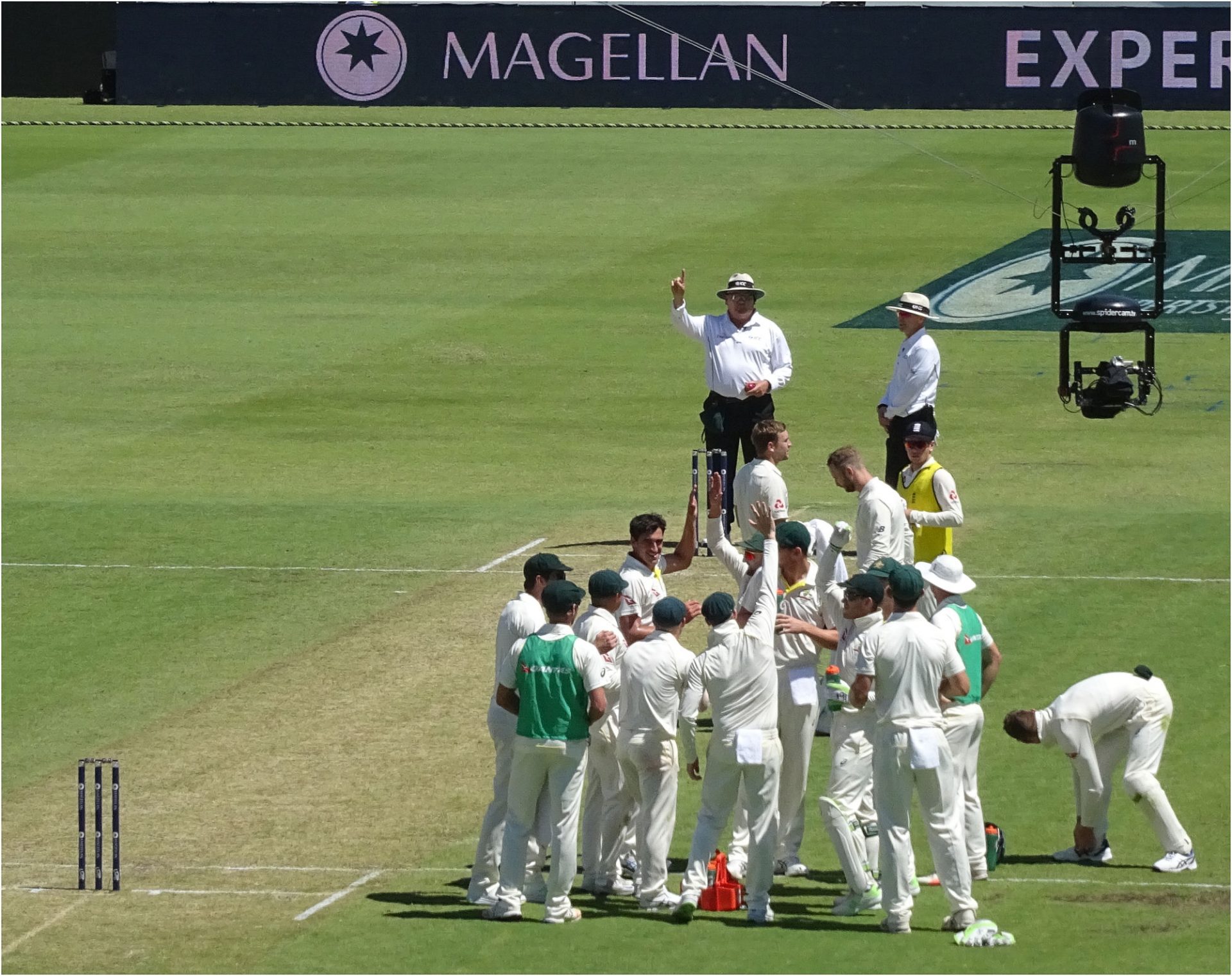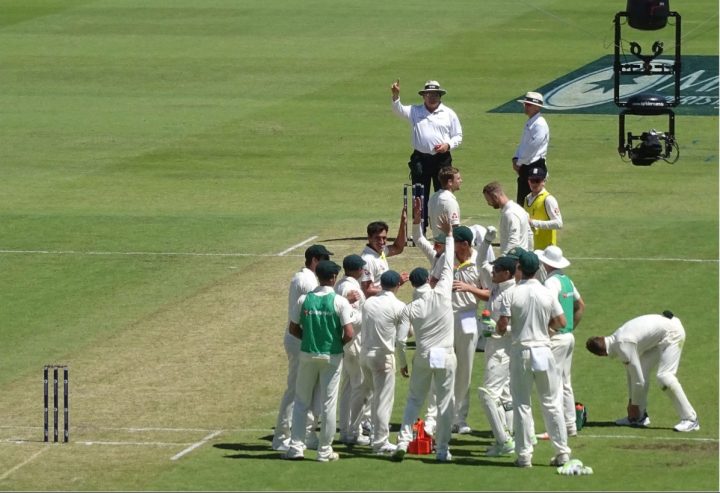In every sport, in every land across the globe, fans will reserve their most vicious bile for the officials. Those responsible for regulating play are the ultimate arbiters of the game. They are never loved, grudgingly respected and occasionally despised. However, cricket is different as umpires maintain an air of gentility and the concealed respect of players and fans. Back in the day, they always wore ties and a white overcoat. A white hat, black trousers and white shoes completed the outfit. They looked more like high street butchers than match officials.
Their pockets would be overflowing with caps and hats; temporary guardians of kit not in use when a player bowled. Sweaters would be hastily tied around their waists, and always carefully handed back lest their charges catch cold. Gradually, their attire assumed a previously unknown vibrancy. Sponsorship and TV money gave them an extended wardrobe for one day matches. The overcoat became a jacket of many colours and the Butlin’s redcoat look suddenly became de rigueur. They might also wear blue, black or a rather fetching shade of powder grey. The overcoat might be discarded but traditional uniform is otherwise preserved for test matches.
Umpires work in pairs, which has its points but I often wonder if it’s a classic case of over manning. One is positioned behind the non-striking batsman and makes the decisions in play. The other umpire stands roughly at square leg but will move position if they are interfering with play. The ‘second’ is there primarily to offer a second opinion, particularly if they had a better vantage point of the incident. As an avid student of the game every day’s a training day; but I really can’t see the point of two umpires. Other sports with two officials doing the same job are there for a good reason; because the pace of the game requires it (e.g. basketball and ice hockey). With the exception of bowls it would be impossible to find a game slower than cricket. The umpire at square leg is essentially ‘the spare’ offering advice where necessary.
As a callow youth watching the game, I soon learnt that umpires had a repertoire of signals that looked more like a freemasons greeting. But of course they gave the appropriate instruction to the scorers. Wagging fingers were always a good sign; a hovering finger side to side was a four whilst furiously rotating fingers held aloft was a six. I recall a strange fascination with umpires shifting stones from one pocket to the other; a primitive method even then for counting balls in an over. The advent of digital technology has transformed the umpire’s role. No longer is he the infallible judge of the game’s rules. On the face of it, new technology and cricket are not ideal bedfellows. There has been an IT based referral system since the early 1990s. The principle being that a third umpire can use video technology to assist in the decision making process.
Umpire reviews can be requested following dismissal decisions especially run-outs and catches. Similarly, captains are permitted up to two unsuccessful challenges per innings under the Decision Review System (DRS). The umpire’s call was introduced in 2016 to enable confirmation of their original decision in the absence of a clear mistake.
What’s truly remarkable about DRS is how smoothly it has assimilated into the game. There may be occasional bumps but generally it has enhanced the umpire’s position as officiator. The pace of the game is tempered by natural breaks in play which lends itself perfectly to DRS. It clicks into action on the jumbotron as players and fans watch patiently for the outcome. Hawkeye provides an engaging series of graphics for all to see. There is no rancour or aggression and umpires are respected. This is in complete contrast to the unadulterated chaos of VAR in football.
Compared to referees in football, umpires have a completely different relationship with the players. It is polite, controlled and almost convivial. Any disciplinary matters are usually routed through the captains. Players adhere to a strict code of conduct that permits no dissent and the resolute acceptance of a decision (DRS permitting). But like all rules, there are exceptions and incidents when players and rarely umpires ‘lose it’.
The most infamous ‘talk back’ to an umpire occurred during England’s tour of Pakistan in 1987. England captain Mike Gatting obviously missed the lecture about etiquette as he launched into a foul mouthed tirade against umpire Shakoor Rana. All semblance of manners disappeared as they angrily traded insults. Jabbing fingers left no gap as they prodded into each other’s chest. The flash point was Rana’s assertion that Gatting had shifted his fielders as Eddie Hemmings came into bowl. It was the second day of the 2nd test at Faisalabad
Pakistan was floundering at 106-5 in response to England’s first innings total of 292. With three balls left before close of play, Gatting brought David Capel to deep square-leg to prevent a single. The England captain claimed he had informed the batsman about the fielding change. But an enraged Rana stopped play and accused Gatting of cheating. It was a deeply unsavoury incident and there was probably fault on both sides. Could it simply be two individuals who tired of each other’s company in such close proximity?
But there are times when players sorely test the benevolence of umpires. I recall Australian spin bowler Ray Bright furiously remonstrating with umpire Bill Alley when he declined to give an LBW decision. He angrily snatched his cap back from a startled Alley. A chorus of boos rang around the ground as captain Greg Chappell was instructed to speak with Bright. The sight was almost comical as Chappell stood in front of the bowler with hands carefully placed on his shoulders. A red faced Bright stared at his feet as the error of his ways were explained. Chappell looked like a despairing parent explaining the facts of life to a naive young son.
Ricky Ponting is a frequent reference point when different aspects of the game are discussed. And bless his cotton socks he hasn’t let me down with a rather nice anecdote about umpires. It was the second day of the 4th test at Melbourne during the 2010/11 Ashes. Australia was on their way to a 3-1 series defeat; England meanwhile would win the 4th test by a gorgeous innings and 157 runs. Ponting was on the threshold of a third Ashes defeat as captain and would not have been in the best frame of mind.
He appealed for a caught behind against England batsman Kevin Pietersen. However, the appeal was rejected by the on-field umpire. Ponting opted for a referral which was subsequently denied by the third umpire. The joys of DRS should have settled the matter there and then. But he became embroiled in an argument and even spoke to Pietersen about the incident. Ponting hadn’t reckoned with the redoubtable Aleem Dar who placed him firmly back in his box.
Dar is now the doyen of umpires having stood in a record 139 tests. He has been voted ICC Umpire of the year on three occasions and broke the five year unbroken run of Simon Taufel. Like many test umpires he had a modest playing career. 17 first class games in Pakistani club cricket was the extent of his achievements as a player. There are some exceptions as Richard Illingworth and Peter Willey both enjoyed solid careers as test umpires. But there remains an element of human nature at work here. Those with unfulfilling playing careers might try harder to prove themselves in other aspects of the game.
The requirement for two on field umpires throws up some memorable partnerships. Probably the greatest umpiring double act was Harold ‘Dickie’ Bird and David Sheppard. Both batsmen, they enjoyed contrasting fortunes as players. Bird was a capable opening batsman with Yorkshire and Leicestershire; but a mixture of poor confidence, indifferent form and a knee injury curtailed his career. Sheppard was an able middle order batsman with Gloucestershire and scored over 10,000 runs in a 14 year career. They stood together in a record 31 test matches and were the yin and yang of test umpires.
They both had an avuncular presence on the field of play. Shep was cheerfully rotund and could easily have been John Bull but for a Union Jack waistcoat. There were many appealing eccentricities that marked him for distinction. Shep childishly skipped every time a player or team reached the dreaded 111 or 222; a superstition that took root during his childhood. He tied a matchstick to his finger on Friday 13th to bring good luck and shook hands with himself to signal a four. Whilst there have been controversial moments Shep was a complete one-off, and rightly given a guard of honour by the Aussies and Kiwis in 2005.
Whilst Shep was flamboyant, Dickie Bird was the charismatic one. He was a talented sportsman and actually preferred football to cricket in his youth. But found his true vocation after his playing career ended and a sparkling stint as umpire began. He rarely gave batsmen out LBW and would bring players off at the first spot of rain. Dickie has dined with the Queen and Margaret Thatcher; he even bantered with Robert Mugabe before Zimbabwe’s inaugural test against India. Flanked by militia with machine guns he was able to tell the President that he knew Thatcher well; diplomatic crisis averted!
The best match officials are the ones you don’t notice and is a tacit sign they are doing their job properly. Only controversy will make them stand out and cricket umpires generally avoid the pitfalls of officialdom. But reality has inevitably caught up as the ICC has ruled that three of the five match officials must be neutral in test matches. Even cricket umpires, it seems, are no longer beyond reproach?
Brian Penn









One advantage of our eighteen first-class counties that I had not considered until now is that our umpires get a great deal of experience. It makes them the best in the world, though individuals from other nations might run the average English Test umpire close. However, to avoid repeats of Shakoor-Rana-type incidents, the standard needs to be kept up worldwide, and it is similarly good for the best umpires to experience all sorts of conditions.
Is this based on any sort of objective measure or is it more “we have to be the best because we’re British”? The Indian domestic competition has over twice as many teams as the British one, for example…
I don’t think anyone is saying that we have the best umpires because we are British, The suggestion, which makes sense to me, is that the County structure in England & Wales helps produce the best umpires in the world.
I know–but what’s the evidence for that other than nationalism?!
I have taken every Test umpire and ranked him according to performance. English male umpires – and Indian female ones – clearly emerge as the best. I suggest you keep your bigoted views on nationalism to yourself, as they do not apply to me.
Tone down the aggression please John. I wasn’t saying anything about you–I was asking for evidence for an argument. You know nothing about my views–and in any case asking for evidence for an assertion doesn’t seem especially bigoted to me.
What I’m asking is what IS your evidence, though–is “I have taken” an ICC table or ranking system? HOW do they emerge as the best–using which criteria? Your argument as written here is little more than “English umpires are the best because I say they’re the best”. Maybe they are, and maybe you have some evidence to support that–but you’re not demonstrating it, you’re just sounding like a child throwing a tantrum in this post.
Sorry to correct you, Brain, but “Shep” was David Shepherd, not Sheppard. I met him a few times, as he and my father taught together in Ilfracombe for a while.
Brian, not Brain (though you might be both!)
Muffin
Well I try to be both! Thanks for the correction. Such is the danger with popular names.
One of Shep’s team mates…:-)
I remember (extreme trivia alert) when the umpires attire changed from long to short coats. They were described by one TMS commentor as looking rather like dentists. On taking the microphone, John Arlott said I suppose it is appropriate that they look like dentists, after all, one of their duties is pulling out stumps !
great Share,
Nice info About a Teamup and Umpire consoles of cricket matches
Their uniforms and outfits are unique to a country or a team and also for a prosperity teamup formations
thank you for feeding this post
keep on work like this
Excellent article. It should be noted that technology has been of huge benefit to the present generation of umpires, particularly in terms of decisions on LBW and no balls.
Colin
I agree with you that technology in general has made for better umpiring decisions where it can establish fact, but I remain firmly against its use in a predictive context with LBW. The very fact that we have umpire’s call, resulting in the farcical situation whereby a different decision is made from the same ball depending on the umpire’s original decision, says to me that it’s predictions are fallible. By all means use it to establish, say, whether the ball pitched in line, but in my view the final decision on likely trajectory should be left to the on field umpire.
“The most infamous ‘talk back’ to an umpire occurred during England’s tour of Pakistan in 1987”.
Colin Croft shoulder-barging Fred Goodall on WI tour of NZ in 1980 is probably more infamous (not sure if Croft technically said anything but his message was clear). That was the tour when Michael Holding kicked the stumps out of the ground – and having seen the incident it seems obvious that the batsman (John Parker) had gloved the ball.
I remember someone (not sure who – it was about rugby referees when there was a media circus around Clive Norling) that a sport is in trouble when there’s more attention on the officials than the players. That’s a sound dictum in my book (I could never stand the obsession with Dickie Bird).
BTW anyone who doesn’t get the reference to freemasonry might start by looking up the hidden hand, the triangle of manifestation and the covering of one eye.
Nice blog information is good. If u want to buy sports equipments check out Best online sport shop in india
The problem for cricket umpires is they constantly have to officiate on game changing decisions. It’s almost like a football ref being inundated with constant penalty appeals or sendings off. The concentration element is key here which is why 2 umpires are needed, so it gives each a break between their overs. Things often happen faster than the eye can see so there has to be an element, even with DRS, of guesswork, however you might like to dress it up. Cricket has always accepted this at every level. The stop start nature of the game helps technology integrate relatively seamlessly, so spectator enjoyment is not really affected as inevitably if their is any doubt in the umpires mind he will refer it upstairs. Better to be safe than sorry.